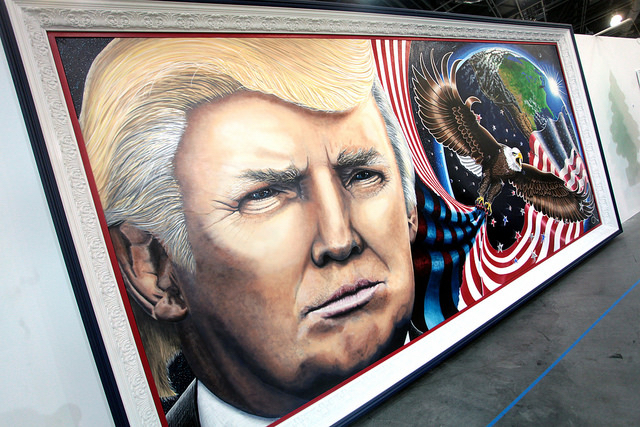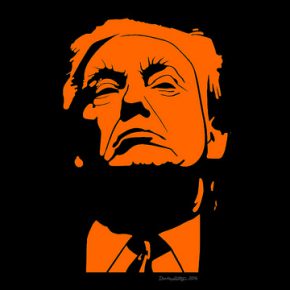Amongst all the frenzied accounting over whom to blame/credit for Donald Trump’s victory, one group has escaped notice – the metalheads. Indeed, there is no evidence that metalheads voted for (or against) Trump (if they voted at all) in greater numbers than anyone else.
As far as we know, there is no ‘metal vote’ in the US. Nor is there any evidence that this metal vote exists anywhere else in the world.
So why write this article then?
Because regardless of whether metalheads are particularly inclined towards Trumpism, metal culture contains elements that have the potential to point towards and reinforce the kind of populist insurgency that boosted Trump and that is spreading across the globe.
In the week following Trump’s victory, I attended a talk in London by the US writer and activist Spencer Sunshine, who is an expert on the far-right. Sunshine’s talk concerned ‘left-right crossover movements’, a fluid set of milieux that constitutes the kind of environment that has bolstered the insurgent ‘alt right’ and, at least in part, Trumpism. The talk impressed upon me the sheer number of overlapping milieux in which racist, fascistic and anti-Semitic ideas circulate. These include not just the ‘traditional’ far right, but also movements for such causes as environmentalism, animal rights and anti-imperialism.
The constant mutations of online-powered movements, and the similarly unanchored nature of modern identity, destabilize traditional political identities and trajectories. So, for example, one might enter environmental politics with a simple desire to preserve the natural world from rampant over-development, only to end up advocating racial separatist ‘back to the land’ ideas. One might enter Palestinian solidarity politics out of outrage at their suffering, only to end up as a Holocaust denier.
There was something very familiar about the picture Sunshine was painting. In participating in and studying metal scenes for over twenty years, their growing heterogeneity has made a strong impression on me. Metal includes everything from anti-fascist grindcore to fascist black metal and all points in between. While metal usually eschews overt politics (of which, more later), the symbols, ideologies and mythologies that circulate within metal scenes, are capable of underpinning a wide variety of political positions: everything from volkish nativism to feminism and anti-racism.
Anti-political discourse, whilst still deeply embedded in metal, has been starting to erode in recent years. Feminist and anti-racist writers and scholars have begun to assert themselves and challenge engrained forms of discrimination and prejudice within metal. The growing prominence of female, queer and non-white performers in metal have forced scenes to confront the diversity and heterogeneity that metal always contained, but often effaced.
The public emergence of difference in metal has not gone unchallenged. There has been an attempt to push back at the ‘SJWs’ through proclaiming a ‘metalgate’, in imitation of the anti-SJW forces that rose to prominence in gamergate. While metalgate never gained the kind of traction that gamergate did, it did highlight a tendency within metal that rejects anything that smacks of liberalism and a concern for social justice. This tendency has much in common with the emergent alt-right, and some metal writers and scenesters such as Brett Stevens and Alex Kurtagic are active in both milieux.
Metalgate has not torn metal apart, and alt-right metalheads are still no more than marginal in metal scenes. For the most part, metal remains a space devoted to worship of the riff, to transgressive thrills and to the joys of sociability. But something has nonetheless changed with Trump’s victory – and changed radically.
As I’ve written elsewhere, metal’s tendency to eschew politics runs very deep and serves an important function: it allows metal to ‘insulate’ itself from the world, enabling the exploration of often highly transgressive aesthetics, symbols and ideologies. This desire for insulation can be seen, for example, from the fact that only a relatively small number of black metal bands have openly embraced fascism and racism, despite the fact that black metal has from its inception been permeated with volkish, nativist and social-Darwinist symbolism and discourse. By deliberately not drawing the dots between the ideas they play with and their political inaction, black metallers stays safe and secure.
What has changed with Trump’s victory is the political prominence of the far right. While the alt-right may well end up being disappointed to a degree by the Trump Administration, the links tying what were once fringe forms of political activity to the ‘mainstream’ have been strengthened. Overt racist and fascist movements were once ghettos, their political activity leading nowhere, their activists generally shunned. Now they are spaces brimming with political possibility.
What all of this means for metal is that the practice of playing with transgressive symbols and ideas suddenly got a whole lot more serious. There are now pathways being laid down that lead from delighting in black metallic misanthropy, to bringing fascist ideas to the White House.
I doubt, at this stage anyway, that many metalheads will take these pathways. Metal culture remains a culture whose first priority is itself. Yet those of us who are involved in metal but are also committed to anti-fascism and anti-racism (in other words, SJWs) are going to have to think hard about how we respond to the changed political context in which metal finds itself.
In particular, we have to think about the indulgence we have traditionally shown to the dodgier forms of metal art. I’m not the only leftist metalhead who gets a thrill from ‘Angel of Death’ and loves Burzum. But whereas once we could revel in these transgressive pleasures, safe in the knowledge that the scene wouldn’t go fascist, we can’t be so smug anymore.
That leads to an acute problem: it is precisely metal’s laissez-faire attitude to flirting with the darkness that made it attractive in the first place. If metal becomes a place of internal censorship and self-censorship, what would be left? I don’t know what comes next but I know this. When I next listen to Burzum, I won’t be under any illusions that this is somehow harmless.
Photograph courtesy of Gage Skidmore. Published under a Creative Commons license.





